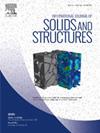Physics-Informed Extreme Learning Machine framework for solving linear elasticity mechanics problems
IF 3.4
3区 工程技术
Q1 MECHANICS
International Journal of Solids and Structures
Pub Date : 2024-11-28
DOI:10.1016/j.ijsolstr.2024.113157
引用次数: 0
Abstract
In neural network-based methods for elasticity mechanics such as Physics-Informed Neural Networks (PINNs), the training process is typically time-consuming due to multiple optimization iterations and reliance on automatic differentiation for gradient computation. This paper proposes a novel framework that combines Physics-Informed Extreme Learning Machines (PIELM) with linear elastic mechanics, focusing on the integration of discretization operators with the principles of linear elasticity mechanics. These discretization operators are constructed based on the form of higher-order derivatives in PIELM, along with governing equations and boundary conditions. Physical information is incorporated into the loss function through discretization operators applied at collocation points. The solution of the proposed method is calculated through the least squares method , which determines the output weights. The comparison with PINN under nonlinear loads and geometric defects demonstrates that PIELM achieves superior error control and prediction accuracy. Furthermore, PIELM achieves more precise in evaluated error norms compared to Finite Element Method (FEM) in a three-dimensional problem with an analytical solution. In conclusion, the proposed method offers an robust and efficient alternative method for linear elasticity.

求助全文
约1分钟内获得全文
求助全文
来源期刊
CiteScore
6.70
自引率
8.30%
发文量
405
审稿时长
70 days
期刊介绍:
The International Journal of Solids and Structures has as its objective the publication and dissemination of original research in Mechanics of Solids and Structures as a field of Applied Science and Engineering. It fosters thus the exchange of ideas among workers in different parts of the world and also among workers who emphasize different aspects of the foundations and applications of the field.
Standing as it does at the cross-roads of Materials Science, Life Sciences, Mathematics, Physics and Engineering Design, the Mechanics of Solids and Structures is experiencing considerable growth as a result of recent technological advances. The Journal, by providing an international medium of communication, is encouraging this growth and is encompassing all aspects of the field from the more classical problems of structural analysis to mechanics of solids continually interacting with other media and including fracture, flow, wave propagation, heat transfer, thermal effects in solids, optimum design methods, model analysis, structural topology and numerical techniques. Interest extends to both inorganic and organic solids and structures.

 求助内容:
求助内容: 应助结果提醒方式:
应助结果提醒方式:


